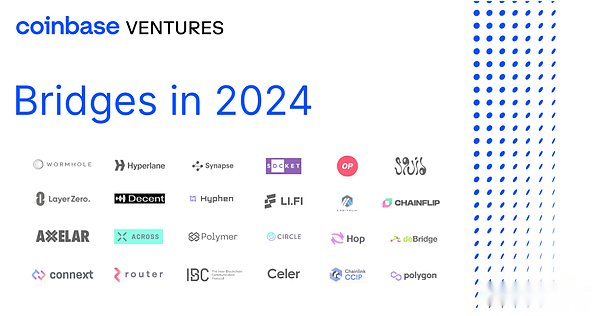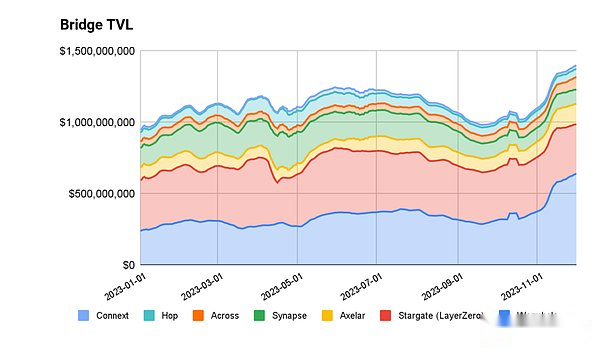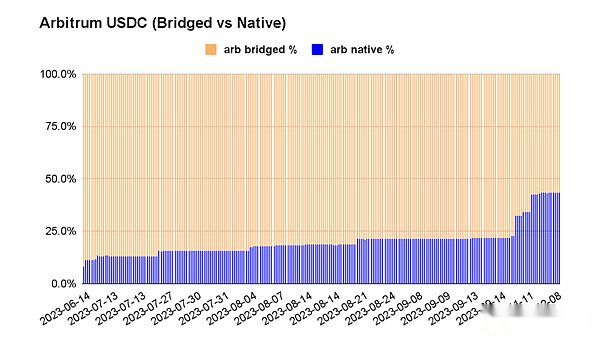
Author: Coinbase Ventures Translation: Shan Ouba, Bitchain Vision
summary
-
With the continuous growth of the number of assets+chain in the encrypted ecosystem, the importance of cross -chain bridges has also increased.
-
The main use case of the bridge is still asset transfer (tokens in one chain with tokens in the other chain)+exchange (trading tokens on the chain A as the tokens on the chain B).Bridges compete in all aspects, such as distribution, product function and security configuration files.
-
Looking forward to the multi -chain distribution technology (such as CCTP), listing, and overlapping with the prophet machine will have an impact on the use and popularization of bridges.
>
Discover and feet:Coinbase Ventures Investment Portrait CompanyThe supported projects are represented by the star number (*) when quoting in the following article.
The bridge has become the core infrastructure of agreement, service providers, and user access to encryption.This report aims to capture the current status of bridge connection, the failure of the bridge, and the impact of a wider extensive encryption ecosystem.
Current Points/Experience lessons
1. Category: The type of bridge can be divided into 3 categories: this machine bridge, part 3 bridge and bridge polymer.
-
Native Bridges: Usually users will interact with them to deposit/withdrawn assets.These can be compatible with bridge compatibility with a group of trusted participants or passing decentralized consensus in compatible operations.Examples include Optimism OP Stack*, Arbitrum Nitro*, COSMOS IBC,SuperbridgeEssence
-
The 3rd bridge: It is a network/verification device located between the chain and acting as a “middleman”.Most bridges follow the variants of this design.Examples include Axlar*, Wormhole*, Layerzero (Stargate)*.
-
Net bridge aggregation: Integrate the first two bridges listed above, and provide the best route for end users/corporate partners.Examples include socket*, li.fi*.
2. The main purpose of the bridge is to provide services for the incremental level of data/assets (ledger/chain/location) and data/assets.The main case is still asset transfer (tokens in one chain and tokens in the other chain)+exchange (trading tokens on the chain A as a tokeer on the chain B).
-
Asset transfer: There is an asset (ETH) on the “A Chain”, which is not native to the “B Chain”.The bridge can provide a service that sends the asset from “Chain A” to “Chain B”.For example, the USDC is received from the ETH L1 bridge to Zora L2 through Zora Native Bridge*.
-
Drop: There is a transaction ($ atom) on “$ ETH) and” Chain B “on” Chain A “.The bridge will send token and then execute the exchange.Examples include [1] Squid Router “exchange” and build it on Axlar “bridge”; [2] Matcha by 0x* is responsible for “exchange” and integrates the socket bridge. “
-
Others: These may include any type of call data or contract ownership, such as governance or multiple signature ownership.For example, the UNISWAP V3 contract is deployed on many EVM chains, but the core governance contract is located on the ETH main network.The Uniswap Foundation*would rather have a contract, and execute messages to other chains in a “one -to -many” manner (instead of creating a governance contract on each chain).
The bridge usually uses AUC (or TVL) on the chain as a symbol of liquidity/usage.
-
Native brides fromAttraction is directly related to the success of L2 itself.The bridge contract will hold funds and can be used as a way to measure the TVL from the bridge to L2.According to L2 Beat, Rollups TVL from ~ 50m to ~ $ 8B.
-
Well -known3rd square bridgeThere are Layerzero, Wormhole and Axlar, which are based on tvL, volume and chain coverage.
-
Layerzero: TVL:About $ 304 million;Transaction volume:~ $ 23.9B;Transaction volume:34.5m
-
Cave: TVL:About 85 billion US dollars;Transaction volume:$ 30B;Transaction volume:1.7 million
-
xlar:TVL:About 224 million US dollars;Transaction volume:$ 7B;trade:1M
PolymerRouting transactions are usually routing, so the transaction volume index is more suitable.The distribution (winning sign) between consumers and enterprises is the key indicator.Leading providers include Socket and Li.Fi.
>
4. Bridge compete in all aspects of differentiation. According to the situation and distribution of the cases, there may be multiple winners.
-
Security: The subtle difference of security depends on the preferences of the demand party.Most consumers who use the bridge seem to prefer speed/delay+cost, rather than the safety of the minimum feasible threshold.
-
Smart contract:Most bridge attacks occur at smart contracts.In most bridges, users lock funds in the contract of chain A → Bridge read chain A contract → coin to the user’s funds on the chain B contract.The error configuration of the withdrawal of the withdrawal permissions in the contract may lead to a hacking attack.
-
Multiple signatures:The control of the contract is entrusted to a trusted participant.These are usually operated by the project team and other trustworthy stakeholders.
-
Relayer + Oracle:Dapps/developers can set their own Relayer + Oracle for their own settings.They can also choose from the option menu settings set by other real -time relay + prophet settings.
-
POS chain:Security is achieved through consensus through proof of equity.
-
Distribution: Bridges will try to use existing partner channels and back -end infrastructure GTM.
-
wallet:Bridges will try to be an infrastructure/API behind the existing wallet/investment combination polymer bridge.For example, Phantom cooperates with Li FI, Coinbase Wallet cooperates with sockets.The front -end / wallet of the investment portfolio will have some form of bridge support (such as Zerion* / Zapper* / Metamask*).
-
B2C front end:Bridges usually set up a website portal, and any user can connect wallet + bridge funds in it.Examples include Stargate.finance (Layerzero), BUNGEE.EXCHANGE (Socket), Jumper.exchange (Li Fi), and Squid Router (Axlar).
-
Dapps:DAPPS itself will contain a “deposit” function that uses a bridge in the background, so the user does not have to jump back to L1, and then jumps back to L2 to use the application.It can be regarded as the abstract version of the above “B2C”, but developers are supported by developers in the application interface.Examples include AEVO *.
-
Developer platform:Many bridge companies will use the existing release of the developer platform to open up.Examples include Conduit Raas, Microsoft Azure + Axlar, Google Cloud + Layerzero.
-
Ecosystem: Although all the main third -party bridges cover all the same chains, they will try to obtain a starting advantage by investing resources in a specific chain/developer ecosystem in a specific chain/developer ecosystem.The reason is that because product function sets need to be more advanced to achieve differentiation, it is easier to expand in the virtual machine/smart contract framework of the ecosystem.
-
EVM:Socket is dedicated to the EVM Rollup ecosystem (OP Stack, Arbitrum*, Polygon* CDK).AEVO and LYRA and other L2 are existing users.
-
Solana:Considering the early participation of worm caves, its ecosystem coverage is wide.Debridge also discovered an attractive growth.
-
Cosmos:Axlar’s ecosystem coverage is wide because they have the ability to provide IBC compatible transactions.A data point is to obtain the first day of coverage using IBC’s new chain store (such as Celestia*).
-
Most providers can provide services to other ecosystems.
-
Product/Functional Collection: Because Bridges is engaged in “abstract” business, they usually need customized smart contracts to support specific use cases.Therefore, the bridge team usually opens up a niche market to find a dedicated vertical field/field.Examples include NFT/Pay (e.g. DECENT), GAS Abstraction, and Sales.
What do we pay attention to
CCTP (CIRCLE’s multi -chain USDC standard) will become an important data point affecting the bridge.CCTP is a standard formulated by Circle* to help the Multintel issuance of USDC.
-
Before CCTP: When the new chain is launched, due to lack of support for native USDC, it will use the bridge version of USDC (because Circle must approve and add support for the native version of each new chain on its route map).Because the chain hopes to get DAY-DEFI support, USDC will bridge from ETH L1, and the bridge version of USDC will become the standard on the new chain.
-
Example:An example may be the USDC on the USDC.E -eth L1 on the Axlusdc or Arbitrum of Axlar, which via AXLAR and Arbitrum bridges, respectively.
-
Influence:This can lead to fragmentation of liquidity, because the USDC of the Chain A bridge and the USDC of the Chain B Bridge have established a dependence on the bridge operators.The DEFI protocol of each ecosystem will integrate it into an asset and it becomes more difficult to release.
-
After CCTP: When a new chain is launched, it will deploy USDC token contracts that meet the CCTP Circle standard.When Circle is ready to go online, it can take over the implementation of CCTP support.Basically, the new USDC contract has backward compatibility to meet subsequent standards.
-
Example:NewChain is a new L2, which has no native USDC.NewChain deploys standard USDC contracts.NewChain supports bridge connection USDC in the short term -but important is that it can be taken over by CCTP, and bridge USDC can become native USDC.
-
meaning:If you are a developer, you usually rely on the USDC to the bridge and be locked to any liquidity plan related to assets and bridges.With CCTP, you can convert to natively enable USDC, and you can click CCTP API to enable the X -chain transmission of USDC.
The adoption of CCTP will affect the long -term defense capacity of the bridge.
-
The bridge USDC (that is, non -CCTP) is locked in the DEFI pool, and will keep this state until it is lifted or becomes a minority share of assets on the chain.
-
Although CCTP will cooperate with the bridge (considering their distribution) to help support CCTP, the adoption of CCTP will naturally lead to an increase in the share of the local USDC and the decrease in the share of the bridge USDC.As an asset that is locked in various DEFI pools, the bridge USDC should naturally thaw naturally in the long run.
-
Example:The ratio of the bridge to the local USDC is:arbitration:[57% – 43%];Base:[33%-67%];optimism:[80%-20%];Polygon:[77%-23%].
-
The story of CCTP will be an important lesson for bridges, which can help them come into contact with asset issuers and lock them as a multi -chain priority at the technical level.Net bridge must compete in other differentiated areas, such as delay, security and distribution.
>
As long as the number of chains and the demand for abstract user experience increased, the bridge will continue to find the purpose.
-
This year, the changes in block space settlement trends (modularity, summary, data availability, etc.) will have an impact on users’ execution of transactions+mobile assets, and bridges will become a popular option to realize this user experience.
-
Over time, the improvement of this machine agreement and technological improvement should help users eliminate the withdrawal period (the current Optimistic Rollup design is 7 days) and obtain the “fast channel” sending/receiving.
-
Veried wallets and users who hold on the future holding chain (such as Coinbase Verifications) may interact with centralized management liquid bridges.
-
Application custody wallets (and self -custody wallets) will continue to work in “Bridge Plus” — the “exchange” and “bridge” are no longer two different transactions, but to merge them into a transaction to obtain it to obtainBetter user experience results.
Bridge and prophecy machine will eventually compete for data distribution.
-
Bridges is striving for first -party issuers to use/use its infrastructure.CCTP shows that local issuers want to build compatibility to reduce dependence on any single network bridge.Some projects are also trying to issue multi -chain token standards.Although CCTP is centered on USDC, the native issue of tokens may be very different.Example: $ OP starts on the Optimism chain natively; most ERCs are released locally on ETH L1.Connext has a token standard called Xerc (CCTP considers any ERC20)
-
The prophecy machine can be considered a “bridge”, but for data issuers in the chain.ChainLink obtains the linked data (cryptocurrency price on the CEFI) and takes it to the chain -Although they do not have the data itself, it provides this data to monetize by providing these data as a third party.Conceptual point of view, this is similar to the way of positioning today.The prophet+bridge will continue to provide services for those who need data/assets and those who can bridge data/assets.In the end, they will need to be a tool for first -party data publishers to maintain long -term moat/defense capabilities.ChainLink has its own bridge, called CCIP, which is further evidence of overlap.
In short, bridges and interoperability will continue to become the primary trend, because in an environment where the number of chains is growing, in order to agree and users meet the needs of abstract user experience, the bridge will become a striking service provider.In the field of bridge, Coinbase Ventures is newly used in the investment bridge.If you build in these areas, we are happy to receive your letter –Ryan Yi’s DM has been openIntersection








